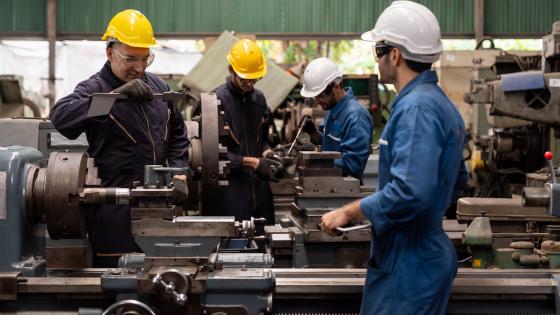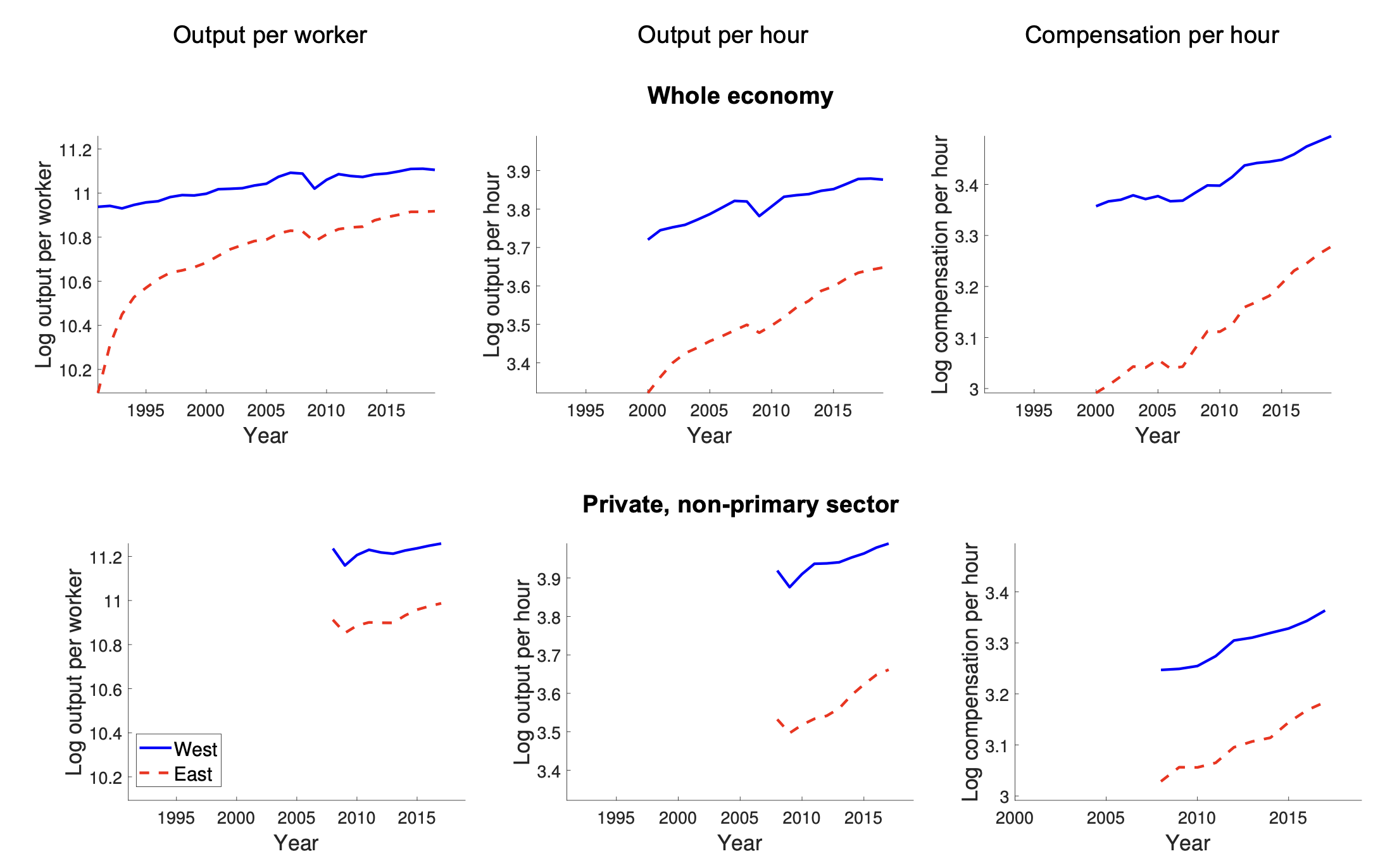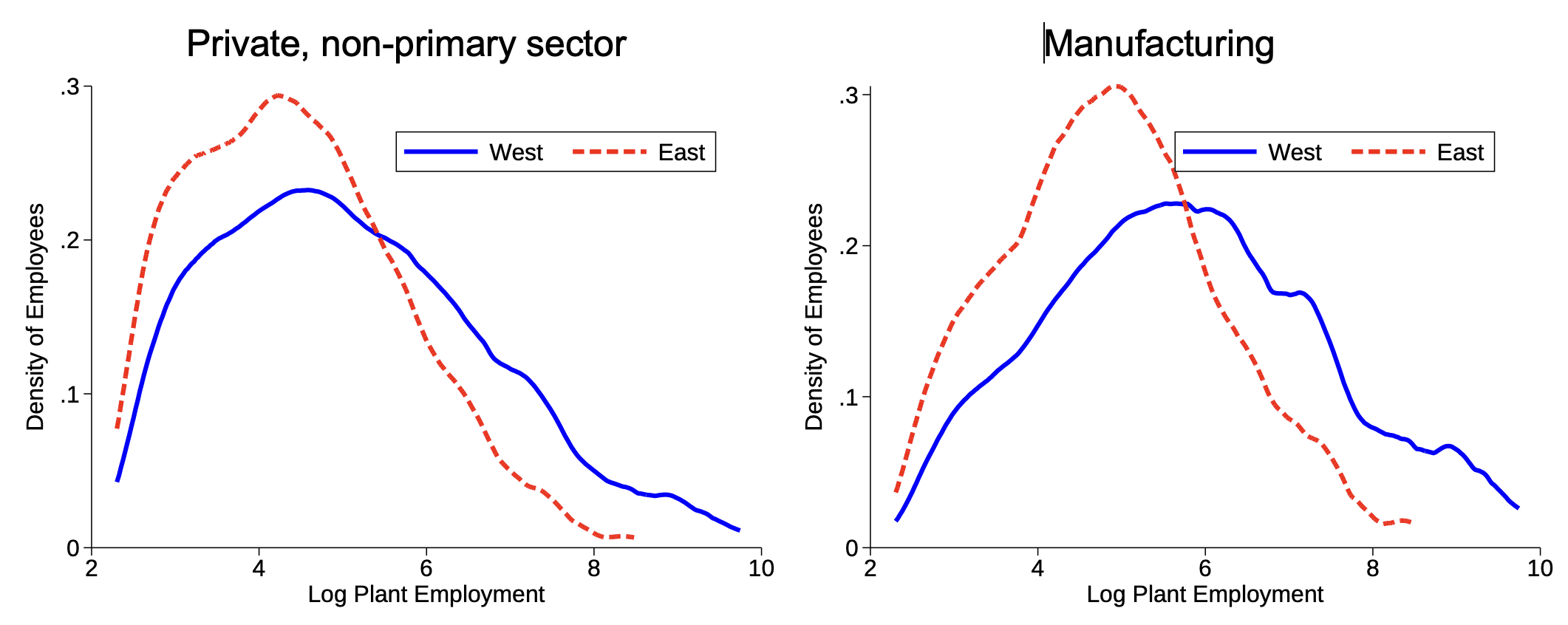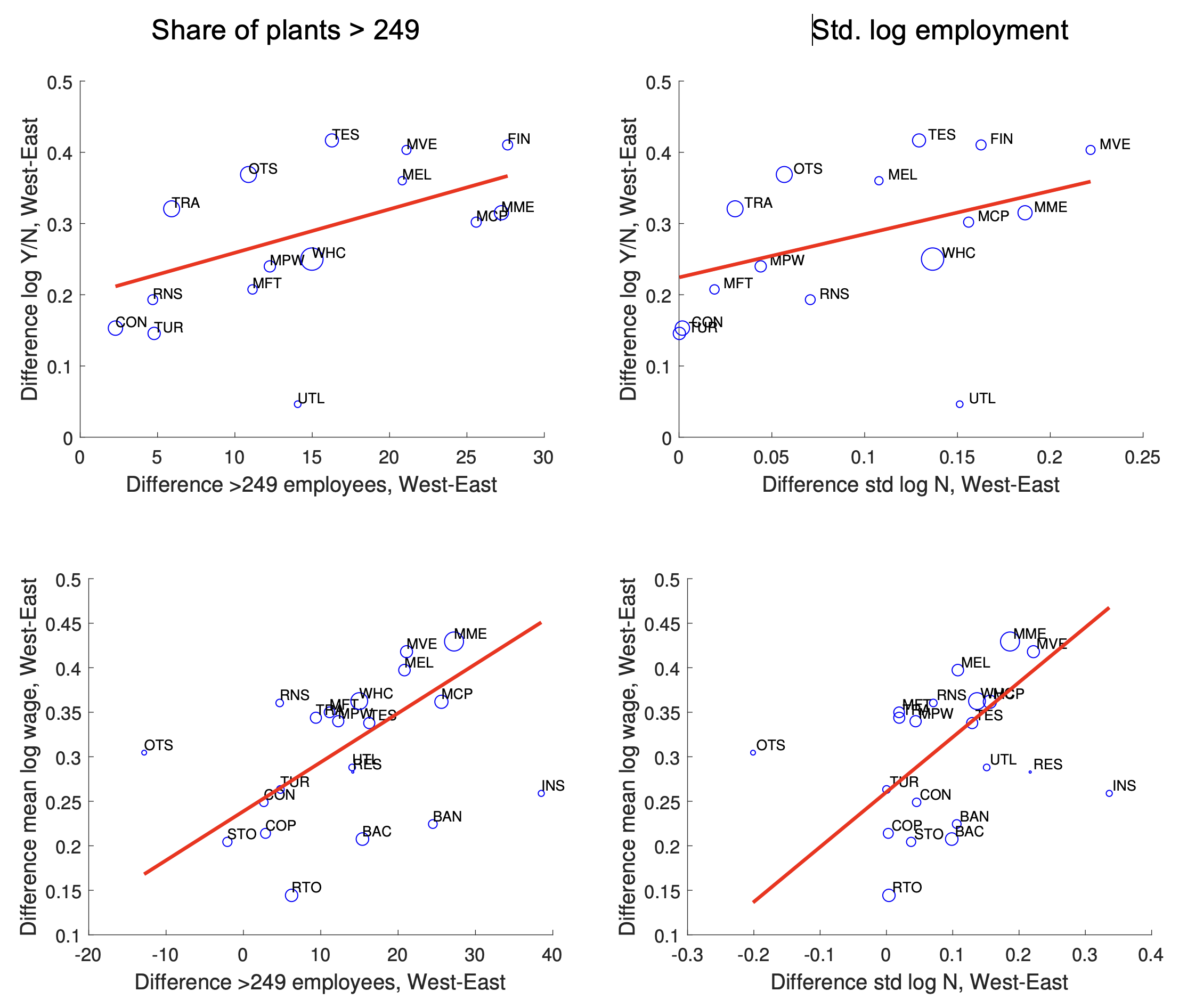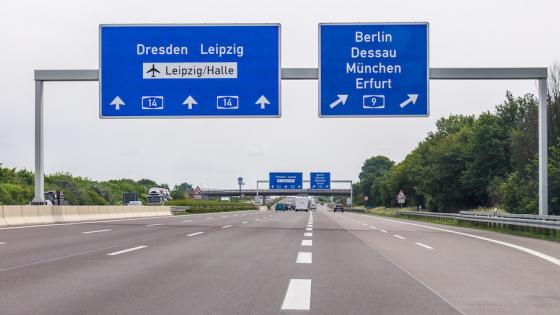Union membership around the world has declined. A large literature has discussed the direct labour market consequences of this trend (Katz and Autor 1999). In this column, we shift the focus towards the macroeconomic and misallocation consequences when employers strategically adjust to selective union retrenchment. The East and West German labour markets provide a good laboratory to study this interaction. Both regions share the same legal and cultural institutions. In East Germany, however, collective bargaining and union membership are underrepresented in small plants for historical reasons. In communist economies, trade unions did not have the role to represent worker interests. Consequently, after reunification, union membership fell dramatically, and union bargaining vanished particularly at small plants (see Schnabel 2005). The size-wage curve for plants, therefore, is steeper in the East than in the West. This creates disincentives in East Germany to choose business models that require a plant to grow large. Consequently, the most productive plants create relatively small customer networks and hire relatively few workers. The aggregate productivity effects of these disincentives are sizeable, as we show in Bachmann et al. (2022). Thirty years after the German reunification, labour productivity and wages remain about 25% lower in East Germany (see Figure 1), and the disincentives from a steeper size-wage curve explain at least ten percentage points of this gap.
We arrive at this conclusion by employing high-quality administrative wage data from two different sources: (1) the German Structure of Earnings Survey (SES), which gathers since 2006 every four years detailed worker-contract information, including hours and wage data, from a large number of plants above ten employees; and (2) the Administrative Wage and Labor Market Flow Panel (AWFP), which collects plant-level data from the German social security files (see Bachmann et al. 2017 for an analysis of German labour market flows with these data). The advantage of the latter is that they are quarterly data since 1993, that is, almost immediately after reunification, but the wage and hours data are of somewhat lower quality compared to the SES. We combine these data with a new heterogeneous-firm model. In this model, plants have product market power and face an upward-sloping size–wage curve when they decide about entry, their customer networks, and their size. In this model, a steeper size–wage trade-off not only generates sizeable negative aggregate productivity effects but also explains, parsimoniously, the differences in the plant size distributions between East and West Germany.
Figure 1 Output and wages
Notes: The figure displays yearly log output per worker, yearly log output per hour, and yearly log labour compensation per hour in East and West Germany. Output is measured as gross value added, which is the GDP concept available at the regional level, because product specific subsidies and taxes (the difference between the two) are only available at the national level. The top panel displays it for the whole economy, the bottom panel for the private, non-primary sector. Calculations are based on national accounts (VGR) from 1992 to 2017. The data is available by region and sector only since 2008, which is why the lower panel starts only in that year. Similarly, data on hours worked by region starts in 2000. Weinand and von Auer (2020) provide county-level consumer price indices for Germany in 2016 that we aggregate to the regional level using population weights. With 2016 as the base year, we then calculate a time series of regional prices using the regional GDP-deflator-based inflation rates from national accounts.
In the data, aggregate and industry differences in labour productivity and wages are systematically related to the absence of large plants in East Germany. The share of employment at large plants with more than 249 employees is almost twice as large in the West (see Figure 2). Even after reunification, plants in East Germany enter their markets smaller than their West German counterparts and remain smaller, as an analysis with AWFP data reveals.
Figure 2 Plant size distribution in East and West Germany
Notes: The figure displays employment-weighted plant size distributions for East and West Germany. The panels display, respectively, an estimated density function (by a Gaussian kernel smoother) in the private, non-primary sector and in the manufacturing sector. We pool to the 2006, 2010, and 2014 samples. Data source: SES 2006/10/14.
In industry-level data, there is a positive correlation between missing large plants and the East-West productivity/wage gap (see Figure 3). For example, vehicle manufacturing has both a particularly large East–West gap in labour productivity (36%) and in the concentration of employment at large plants (21 percentage points), while construction has a smaller labour productivity gap (14%) and virtually the same concentration in East and West Germany.
What is more, the lack of large plants, lower productivity, and lower wages are systematically related to differences in size-wage curves, which we estimate separately for East and West Germany, as well as by industry, from the SES data. On average, the plant size elasticity of wages is one fifth larger in East Germany relative to West Germany. The industries with steeper size-wage curves in the East are also those industries with particularly many missing large plants and particularly low average wages. In turn, the steeper size–wage curves in the East can be traced back to the fact that workers at small plants in the East are more likely to have individually and not collectively bargained wages compared to their Western counterparts, an example of non-uniform union retrenchment.
Figure 3 Productivity and wage differences and large plants by industry
Notes: The top panels relate 2014 log differences in output per worker between West and East Germany within industries to the share of employment at plants with more than 249 employees (left panels) and the standard deviation of log plant employment (right panels). Output is measured as gross value added, which is the GDP concept available at the regional level, because product-specific subsidies and taxes (the difference between the two) are only available at the national level. The lines show (VGR) employment-weighted least squares regressions. The bottom panels relate differences in mean log wages between West and East Germany within industries to the same plant size measures. The lines show (SES) employment-weighted least squares regressions. Data sources: SES 2006/10/14 (plant sizes, wages) and VGR (labour productivity).
To quantify the effects of a steeper size–wage trade-off on the plant size distribution and aggregate labour productivity, we employ a heterogeneous-plant model. First, plants decide about market entry. After market entry, they choose how many customers to acquire, trading off additional sales and marketing expenses. This customer base choice also takes into account the labour needed to supply additional customers and, thus, that a larger customer base drives up wages in line with the upward-sloping size-wage curve present in the data. Finally, plants, taking into account their product market power, decide about prices charged to each individual customer and, thereby, about the number of workers required to service this customer.
The trade-offs plants face in these decision problems lead them to acquire fewer customers the steeper the size-wage schedule is that they encounter. Indeed, in the data, marketing expenses are particularly small in those industries in East Germany, which have a particularly steeper size–wage curve compared to their West German counterparts. This has two effects on aggregate productivity. First, as plants on average have an incentive to remain small and acquire few customers, the average customer bundles from fewer plants. That is, monopsony power in the labour market creates an adverse love-of-variety effect in the product market, which makes the economy less efficient. Second, compared to a situation with lower monopsony power, the employment distribution across plants is compressed, and labour is reallocated from more to less productive plants. Again, the result is an aggregate productivity loss. This second effect is exacerbated by product market power.
We calibrate the model to the average plant size and the share of large plants in West Germany. Imposing the steeper size–wage trade-off from East Germany explains a ten percentage points lower productivity in that region. In addition, untargeted, the model replicates the plant size distribution in East Germany. That is, it matches the smaller average plant size and the relatively small number of large plants.
There are a number of alternative explanations for the lack of convergence in aggregate labour productivity between East and West Germany. First, this phenomenon could result from a lower capital intensity, older-vintage capital, or lower labour quality in East Germany, in which case, different from our explanation, the root cause of the problem would not necessarily be total factor productivity differences. Second, the phenomenon could result from aggregate total factor productivity differences which have different sources than our explanation, such as a higher degree of labour market flexibility in West Germany or differences in industry composition. Third, the total factor productivity differences and the corresponding differences in plant size distributions could be the result of agglomeration effects in metropolitan areas and West Germany simply having more of those. None of these alternative explanations has strong support in the data as far as the persisting lack of convergence is concerned, although some of them might have played a role in the immediate aftermath of the reunification (e.g. Dauth et al. 2021). We do not address why workers do not reallocate to West Germany despite higher wages, a fact for which Heise and Porzio (2020, 2021) provide an interesting complementary explanation based on regional home bias in labour markets and reallocation costs. By contrast, we seek to explain the lack of firm mobility between East and West and the resulting lower aggregate total factor productivity in East Germany from a combination of market imperfections.
Our model highlights two pathologies arising from monopsony power in the labour market in addition to the fact that monopsony power usually leads to lower aggregate employment: Productive businesses attract a lower number of workers and build too small customer bases, which is a form of reduced investment. Neither wage (the usual policy recommendation in the presence of labour market monopsony power) nor market entry subsidies can cure these pathologies. By contrast, they could be partially cured by marketing subsidies. They incentivise plants to build up a larger customer base than they do in the laissez-faire equilibrium and thus increase productivity. Alternatively, collective bargaining agreements through trade union presence might be needed in more small and medium-sized plants in East Germany.
References
Bachmann, R, C Bayer, H Stüber and F Wellschmied (2022), “Monopsony makes firms not only small but also unproductive: Why East Germany has not converged”, CEPR Discussion Paper 17302.
Bachmann, R, C Bayer, C Merkl, S Seth, H Stüber and F Wellschmied (2017), “Worker churn and employment growth at the establishment level: Evidence from Germany”, VoxEU.org, 1 November.
Dauth, W, S Findeisen, T Lee and T Porzio (2021), “Transforming Institutions: Labor Reallocation and Wage Growth in a Reunified Germany”, Mimeo Columbia University.
Heise, S and T Porzio (2021), “The Aggregate and Distributional Effects of Spatial Frictions”, NBER Working Paper No. 28792.
Heise, S and T Porzio (2020), “Why East Germans are not taking advantage of the large wage gap between East and West Germany”, VoxEU.org, 29 February.
Katz, L F and D Autor (1999), “Changes in the Wage Structure and Earnings Inequality”, Handbook of Labor Economics, vol. 3, Elsevier, 1463–1555.
Schnabel, C (2005), “Gewerkschaften und Arbeitgeberverbände: Organisationsgrade, Tarifbindung und Einflüsse auf Löhne und Beschäftigung”, Zeitschrift für Arbeitsmarkt Forschung-Journal for Labour Market Research 38: 181–196.
Weinand, S and L von Auer (2020), “Anatomy of Regional Price Differentials: Evidence from Micro-Price Data”, Spatial Economic Analysis 15: 413–440.
